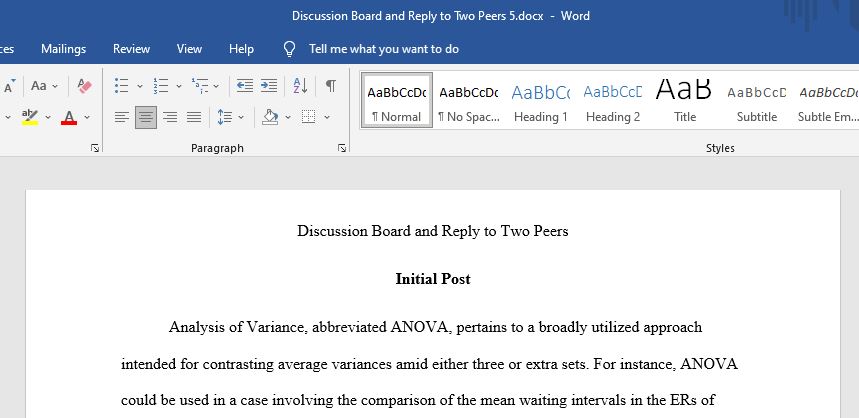Discussion Board and Reply to Two Peers
This Discussion explores three common types of statistical analysis. You have been assigned a topic according to the first letter of your last name (M). Please identify the topic assigned to you below. For each topic, find a health-based example of it in a published research study or news article; the Library is an excellent resource for finding examples. Summarize how your topic is used in the example. In your response, specifically explain why the test is well-suited for your example. Please post a response of at least 150 words to the topic. Your required follow-up replies should have at least 75 words each. Please format any references in APA style and include a citation for information that you paraphrase or quote.
Topic 1
(for last names beginning with A–H): t test
Topic 2
(for last names beginning with I–P): ANOVA
Topic 3
(for last names beginning with Q–Z): Regression and Correlation
Although not required, it is recommended that you plan your reply posts so that you reply to topics that you did not cover within your main post.
JASON ADAMS T-TEST UNIT 4 POST
Jason Adams posted Apr 17, 2021 2:33 PM
This page automatically marks posts as read as you scroll.
Adjust automatic marking as read setting
Good Afternoon Class,
A T-Test is used to compare the means of two samples from one another. When this is done correctly, the researcher can then use the outcome to see how different the samples are from each other (Jankowski, Flannelly & Flannelly, 2018). For example, this can be used to see the outcome of post-birth morbidity of infants during their first eight weeks of life. A study was conducted in 2014 that examined the morbidity of 139 infants born from low-income first-time mothers during the first eight weeks after a healthy birth. The data was analyzed and compared to randomized healthy infants born during the same time frame. The researchers used two-sample t-test and other descripted statistics to compare the two groups. The purpose of this study was to gather data to see how increasing health cost, health care budget cuts and lack of infant morbidity surveillance was affecting the lower class. After gathering the data, the T-Test was used twice in the study. It was used to verify the mean of “Mother Age” and “Years in Relationship”; both calculating a result of T=0.23. The study did suggest that for the lower income family, upper respiratory illness was more common and resulted in more financial hardship compared to the average American.
*******************************************************
T-TEST DATA:
Mother’s age (mean) 24.1 (SD = 4.0) 24.5 (SD = 4.3) 23.7 (SD = 3.8) t = 0.23*
Years in relationship (mean) 2.9 (SD = 3.0) 2.9 (SD = 2.8) 2.8 (SD = 3.3) t = 0.23
********************************
-Jason Adams
REF:
Hannan, J. (2014). Newborn Morbidities and Health Charges: The First Eight Weeks. Pediatric Nursing, 40(3), 121-6. https://libauth.purdueglobal.edu/login?url=https://www-proquest-com.libauth.purdueglobal.edu/scholarly-journals/newborn-morbidities-health-charges-first-eight/docview/1545343308/se-2?accountid=34544
Jankowski, K. R. B., Flannelly, K. J., & Flannelly, L. T. (2018). The t -test: An Influential Inferential Tool in Chaplaincy and Other Healthcare Research. Journal of Health Care Chaplaincy, 24(1), 30–39. https://doi.org/10.1080/08854726.2017.1335050DB
Week 4
Regina Brzak posted Apr 14, 2021 10:42 PM
The
New York City Health and Nutrition Examination Survey conducted a study
on adults’ blood pressures over the age of 20 in the NYC area using two
different devices. The study wanted to see if there was a difference
between blood pressure readings because of the devices. There were 167
volunteers within the study. In 2004, each volunteer blood pressure was
measured using an auscultatory mercury sphygmomanometer within a clinic
setting. In 2013-2014 the volunteers measured blood pressure in their
homes using the oscillometric LifeSource UA-789AC monitor. The study
used the paired t-test to look for any “significant differences
in the in mean systolic and diastolic blood pressure between devices
for overall and by mid-arm circumference categories”. (Kanchi et al,
2019) The researchers used the Bland-Altman graphs to be able to study
the differences between the two devices. In the end, the Bland-Altman
graphs did not show significant differences, the systolic readings were
on average the same, and the diastolic averages were a little higher
using the oscillometric LifeSource UA-789AC monitor.
References:
Kanchi, R., Perlman, S., Ostchega, Y., Chamany, S., Shimbo, D.,
Chernov, C., & Thorpe, L. E. (2019). Calibrating Local
Population-Based Blood Pressure Data from NYC HANES 2013-2014. Journal of Urban Health : Bulletin of the New York Academy of Medicine, 96(5), 720–725. https://doi.org/10.1007/s11524-019-00385-x
Answer preview:

word limit:415
